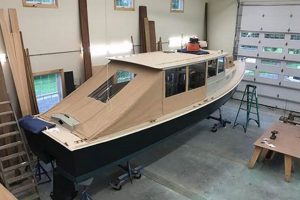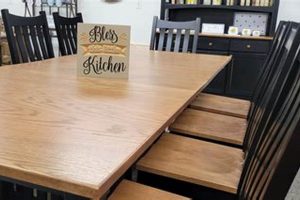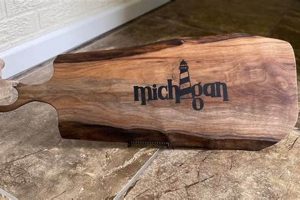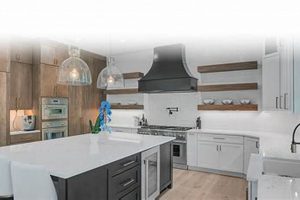The creation of wooden structures and objects tailored to specific requirements distinguishes this craft. Unlike mass-produced items, each piece is designed and constructed according to individual needs and preferences. For instance, a homeowner might commission unique cabinetry designed to fit an awkwardly shaped kitchen, optimizing storage and aesthetics.
Value stems from its ability to meet precise demands, maximizing functionality and reflecting personal style. Historically, it represented a cornerstone of construction and design, with skilled artisans creating bespoke pieces for residences, institutions, and more. The practice showcases an understanding of material properties and construction methods, creating enduring and aesthetically pleasing results.
The following sections will explore the processes involved in its creation, the range of materials used, considerations for design and durability, and avenues for finding qualified professionals. This includes analysis on project planning, material selection and construction techniques to provide a deeper understanding of the subject.
Essential Considerations for Commissioning Tailored Wood Projects
This section offers guidance for those considering commissioning specialized wood projects. These points will aid in achieving successful outcomes.
Tip 1: Define Project Scope Clearly: Establishing specific requirements at the outset is crucial. Detailed drawings, measurements, and material specifications should be documented to ensure precise execution. Ambiguity can result in deviations from intended design.
Tip 2: Select Appropriate Wood Species: Different wood types exhibit varying levels of durability, workability, and aesthetic qualities. Mahogany might be preferable for fine furniture due to its stability and grain, while oak could be selected for its strength in structural applications.
Tip 3: Verify Joinery Techniques: The method of joining wood components directly affects structural integrity and longevity. Dovetail joints, mortise-and-tenon joints, and proper use of fasteners are all fundamental to durable construction.
Tip 4: Confirm Finishing Processes: The finish protects the wood surface from moisture, abrasion, and ultraviolet light. The selection of appropriate stains, sealants, and topcoats will affect aesthetics and resistance to wear.
Tip 5: Establish a Realistic Budget: Costs vary significantly depending on materials, complexity, and labor involved. Obtaining multiple quotes from experienced professionals helps to assess fair market value.
Tip 6: Inquire About Maintenance Requirements: Proper care extends the life of the piece. Understanding cleaning methods, humidity control, and potential refinishing needs are integral to maintaining its condition.
Tip 7: Review Portfolio and References: Examining prior work provides valuable insight into a woodworker’s skill and attention to detail. Contacting past clients offers an understanding of their work ethic and customer service.
Tip 8: Draft a Comprehensive Contract: A formal agreement outlines scope, timelines, payment schedules, and warranty provisions. This document serves as a legal framework to protect all parties involved.
Adhering to these principles can optimize the value and longevity of commissioned wood projects, ensuring satisfaction and enduring quality.
The following sections will address various facets of maintaining specialized wood structures and pieces.
1. Precision
Accuracy constitutes a cornerstone of superior specialized woodworking. Dimensional exactness, meticulous joinery, and adherence to specified angles directly impact both the structural integrity and aesthetic appeal of the finished product. Deviations from planned dimensions in a custom-built staircase, for example, can compromise safety, create visual disharmony, and necessitate costly rework. Such errors can stem from inaccurate measurements, improperly calibrated equipment, or inadequate understanding of material properties. The absence of precision, therefore, directly undermines the intended quality and functionality of the piece.
The application of precise techniques is also seen in fine furniture making. Consider the creation of a dovetailed drawer. Accurate cutting of the dovetails and pins ensures a tight, seamless fit, which not only enhances the visual appeal but also provides superior strength compared to less precise joinery methods. Similarly, in architectural woodworking, accurately milled moldings and trim are essential for achieving crisp, clean lines and a refined aesthetic. These precise elements contribute significantly to the overall perceived value and longevity of the item.
In summary, precision in custom woodworking is not merely a desirable attribute but a fundamental requirement. Neglecting it compromises structural soundness and visual harmony and functional usability. Understanding this crucial aspect is essential for both the craftsman and the client, influencing every phase from initial design to final installation. Ensuring a focus on precision mitigates risks, reduces potential for errors, and maximizes the potential for exceptional, lasting pieces.
2. Durability
The longevity and structural integrity of specialized woodwork are inextricably linked to its inherent durability. The choice of materials, construction methods, and protective finishes directly determine resistance to wear, environmental factors, and physical stress. Inferior materials or substandard construction techniques inevitably result in premature degradation, diminished functionality, and reduced lifespan. For example, an exterior door crafted from untreated softwood will succumb to rot and warping, whereas one fashioned from durable hardwood and properly sealed will withstand the elements for decades. The relationship between durability and specialized woodworking is thus causal: robust construction ensures sustained utility.
The practical significance of this understanding extends beyond mere product longevity. Durable pieces minimize the need for frequent repairs or replacements, yielding long-term cost savings and reducing resource consumption. Additionally, durability contributes to the preservation of aesthetic qualities; a well-maintained, resilient surface retains its visual appeal over time. Consider custom-built library shelves designed to withstand heavy loads of books for many years. Using kiln-dried hardwood coupled with robust joinery makes its stability paramount. Without such durability considerations, the shelves may sag or warp, leading to functional and aesthetic degradation. The focus on material and construction directly correlates with the enduring quality of the specialized woodworking.
In summary, durability is not merely an attribute of specialized woodworking, but an essential component determining its value and sustainability. By prioritizing material selection, construction, and protective measures, it’s possible to create pieces that withstand the test of time, delivering enduring functionality, cost-effectiveness, and aesthetic appeal. This approach represents a long-term investment that minimizes environmental impact and upholds the value of skilled craftsmanship. The challenges lie in balancing cost considerations with durability needs, but ultimately prioritizing long-term value over short-term savings yields the most satisfying outcomes.
3. Aesthetics
Aesthetics, in relation to tailored wood structures, represents a critical determinant of perceived value and satisfaction. Visual appeal directly influences the integration of these crafted items into their intended environment and their capacity to evoke desired emotions or convey specific design intentions. The careful selection of wood species, finishes, and design elements dictates the aesthetic character. For example, the choice of walnut for a conference table, coupled with a matte finish, may convey sophistication and professionalism, while a rustic, reclaimed wood design might evoke a sense of warmth and history. Thus, aesthetics serves as a key driver of both emotional connection and practical alignment with design objectives.
The impact of aesthetics extends beyond surface-level visual considerations to encompass functional aspects. Ergonomic design principles, which prioritize user comfort and efficiency, directly contribute to the overall aesthetic experience. A well-designed custom chair, for instance, may be visually appealing but also provides optimal support and posture. The integration of form and function, therefore, elevates the aesthetic value. In architectural applications, aesthetics determines how woodworking elements interact with surrounding spaces, influencing light flow, spatial perception, and overall atmosphere. Carefully selected wood paneling or intricate moldings can transform the character of a room, adding depth, texture, and visual interest. A failure to consider these interactions can result in visual disharmony and a diminished aesthetic impact.
In summary, aesthetics in custom wood structures represents far more than a superficial element; it is a fundamental component that drives emotional resonance, functional integration, and design harmony. Addressing aesthetic concerns is essential in realizing the intended design goals. Recognizing the relationship between material choice, design execution, and spatial integration is crucial for maximizing visual impact and achieving customer satisfaction. Meeting these expectations is essential for both designer and client.
4. Functionality
The core objective of bespoke woodwork is to fulfill specific functional requirements. The design and execution of such projects are driven by the intended use and performance characteristics demanded by the client. A custom-built workbench, for example, is not merely a visual object but a tool designed to optimize workflow, provide ample storage, and withstand the rigors of daily use. The dimensions, material selection, and integrated features such as vises or power outlets directly impact the workbench’s effectiveness and utility. A failure to prioritize functionality in the design phase renders the finished product aesthetically pleasing, yet deficient in its primary purpose.
Practical applications further highlight the centrality of functionality. Consider the creation of custom cabinetry for a restaurant. The design must account for efficient storage of kitchenware, accessibility for staff, and compliance with health and safety regulations. Shelves need to be sized appropriately for different types of dishes and equipment, while doors must open smoothly without obstructing movement. Similarly, custom reception desks in commercial spaces often integrate specific technological components, such as computer monitors, phone systems, and security access controls, all of which must be seamlessly incorporated into the overall design without compromising accessibility or ergonomic comfort. If all are functionally integrated.
In summary, functionality represents an indispensable element of specialized woodwork. Prioritizing its needs is key to maximizing the practical value and long-term usability of custom-made creations. Acknowledging the cause-and-effect relationship between design choices and functional performance allows for the creation of products that meet the unique needs of the end-users, ultimately enhancing their productivity, safety, and satisfaction. These structures can be aesthetically pleasing, or otherwise fall short of the intended functional purpose.
5. Sustainability
The integration of sustainability principles into customized wood construction represents a convergence of environmental responsibility and design innovation. The selection of sustainably harvested wood, utilization of non-toxic finishes, and optimization of material usage minimize ecological impact. Consider, for instance, a custom-designed home featuring locally sourced, reclaimed timber for structural elements. The sourcing diminishes demand for virgin timber, reducing deforestation and preserving biodiversity. Simultaneously, the utilization of low-VOC (volatile organic compound) finishes mitigates air pollution and protects the health of occupants. The outcome is a construction project that adheres to specific design parameters, yet adheres to sustainability principles.
Practical implications are significant. Embracing sustainability reduces carbon footprints, promotes responsible forest management, and encourages the development of environmentally sound building practices. A commercial enterprise commissioning custom furniture for its offices may stipulate the use of Forest Stewardship Council (FSC) certified wood, assuring consumers the furniture originated from well-managed forests. This decision supports responsible forestry operations and enhances the company’s brand image, promoting corporate social responsibility. The life cycle assessment (LCA) approach evaluates the environmental impact of custom wood products. Such assessments identify points of intervention for improved sustainability performance, from material sourcing to end-of-life considerations.
In summary, sustainability is not merely a desirable addendum to specialized wooden structures, it is a cornerstone of responsible design and construction. Prioritizing environmental considerations throughout the entire process, from material selection to finishing, fosters ecological balance, promotes resource conservation, and enhances the long-term value of crafted wood products. Challenges remain in overcoming cost premiums associated with sustainable materials, but the increasing availability of eco-friendly alternatives and growing consumer demand are driving positive change within the woodworking industry.
6. Craftsmanship
Craftsmanship, in the realm of tailored wood constructions, represents the cornerstone of quality, durability, and aesthetic distinction. It’s more than mere technical skill; it embodies a dedication to precision, material understanding, and an unwavering commitment to excellence. The absence of robust craftsmanship directly undermines the value and longevity of bespoke wood projects.
- Mastery of Traditional Techniques
Effective craftsmanship integrates time-honored techniques, such as mortise-and-tenon joinery, dovetailing, and hand-planing. These methods, refined over centuries, offer superior strength, stability, and visual refinement compared to modern mass-production techniques. For example, a hand-cut dovetail joint in a custom-built dresser demonstrates meticulous skill and creates a durable, aesthetically pleasing connection.
- Deep Material Knowledge
Expert craftsmanship hinges on a profound understanding of wood properties, including grain structure, moisture content, and species-specific characteristics. This knowledge informs the selection of appropriate materials for particular applications and guides the proper handling and preparation of wood components. For instance, understanding how different wood species react to seasonal changes is critical when constructing a custom-made exterior door to prevent warping and cracking.
- Precision and Attention to Detail
Craftsmanship demands unwavering precision throughout the entire construction process, from initial measurements and cutting to final finishing. Even minor discrepancies can compromise structural integrity or aesthetic harmony. A custom-built staircase, for example, requires exact measurements and careful alignment to ensure safe and comfortable use. The pursuit of precision reflects a dedication to excellence and elevates the overall quality of the finished product.
- Artistic Vision and Design Integration
Exceptional craftsmanship extends beyond technical expertise to encompass an artistic vision and the ability to seamlessly integrate design elements. This includes understanding proportion, balance, and the interplay of light and shadow to create visually compelling and harmonious pieces. Consider a custom-carved headboard, where the craftsman skillfully blends intricate details with overall design aesthetics, resulting in a visually stunning focal point for the bedroom.
These elements intertwine to form a holistic approach to tailored wood creation, ensuring that each project is not merely assembled but meticulously crafted. This dedication translates into superior quality, durability, and aesthetic appeal, thereby elevating the perceived value and overall satisfaction of the bespoke wood structure.
Frequently Asked Questions
The following addresses common inquiries regarding the procurement, construction, and maintenance of custom wooden structures and objects. These responses aim to provide clarity and assist in informed decision-making.
Question 1: What distinguishes creations from mass-produced alternatives?
The primary distinction lies in the tailoring to specific requirements. Unlike standardized items, each piece is designed and constructed to meet precise dimensions, functional needs, and aesthetic preferences. This results in a unique item optimized for its intended purpose.
Question 2: How is the cost determined for these projects?
Pricing is influenced by several factors, including the complexity of the design, type and quantity of materials used, labor hours required, and any specialized finishing techniques employed. A detailed quotation should be obtained from the chosen artisan, outlining all anticipated expenses.
Question 3: What wood species are most suitable?
The selection depends on the application and desired characteristics. Hardwoods like oak, maple, and walnut offer durability and aesthetic appeal for furniture and cabinetry. Softwoods such as pine and cedar are often used for structural elements and outdoor applications. The appropriate species should align with the project’s functional and aesthetic requirements.
Question 4: What precautions should be taken to ensure longevity?
Proper maintenance is essential. This includes regular cleaning with appropriate products, protecting surfaces from excessive moisture and sunlight, and periodic refinishing or repair as needed. Adhering to recommended maintenance guidelines will maximize the lifespan of the wood structure.
Question 5: How does the selection of finish impact the final product?
Finishes serve both aesthetic and protective purposes. Stains enhance the natural grain of the wood, while sealants and topcoats protect against moisture, abrasion, and UV light. The choice of finish affects the appearance, durability, and maintenance requirements of the finished piece.
Question 6: How is a reputable woodworker identified?
Verification of credentials, portfolio review, and client references are essential steps. Seeking experienced professionals with a proven track record ensures that craftsmanship aligns with expectations. Clear communication and a formal contract are crucial for a successful project.
Understanding these fundamental aspects enables effective planning and execution of specialized wood projects, ensuring satisfactory outcomes and long-term enjoyment.
The subsequent section delves into detailed case studies demonstrating practical applications and innovative approaches.
Custom Made Woodwork
This article has explored the multifaceted nature of custom made woodwork, encompassing its definition, benefits, considerations, and practical applications. Emphasis has been placed on the importance of precision, durability, aesthetics, functionality, sustainability, and craftsmanship as critical determinants of success. This exploration underscores the value in understanding these factors to ensure optimal outcomes in bespoke wood projects.
The enduring appeal of this practice lies in its ability to meet specific needs and reflect individual expression. As design trends evolve and environmental consciousness grows, the demand for personalized, sustainable, and expertly crafted wooden structures will continue to increase. Recognizing its value will ensure its continued contribution to enriching built environments and promoting responsible craftsmanship.







